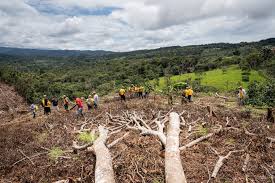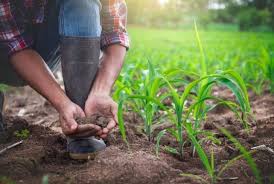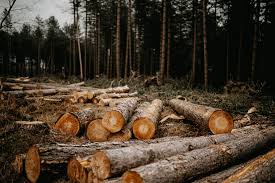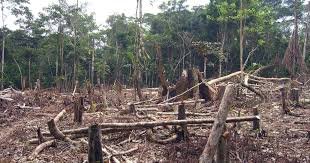Deforestation is the large-scale removal of trees and forests, primarily to make way for agricultural activities. This practice has significant implications for biodiversity, climate change, and local communities.
Understanding the causes and consequences of deforestation related to agriculture is essential for developing sustainable land-use practices.
Causes of Deforestation for Agriculture
1. Agricultural Expansion: The primary driver of deforestation is the need for more land to grow crops and raise livestock. As global food demand rises, forests are often cleared to create farmland.
2. Cash Crop Cultivation: The cultivation of cash crops like soy, palm oil, and coffee can lead to deforestation as farmers convert forests into plantations to maximize profit.
3. Livestock Farming: Cattle ranching is a significant cause of deforestation, especially in regions like the Amazon rainforest, where large tracts of land are cleared for grazing.
4. Infrastructure Development: Roads, buildings, and other infrastructure projects associated with agricultural development often lead to increased deforestation, as they open up previously inaccessible forest areas.
5. Poverty and Land Tenure Issues: In some regions, poverty drives communities to clear forests for subsistence farming. Additionally, unclear land tenure can lead to unsustainable land use practices.
Types of Agricultural Land Expansion

1. Shifting Cultivation: This traditional practice involves clearing a small area of forest for agriculture and then moving to another area after a few years, allowing the original land to regenerate.
2. Permanent Cultivation: This method involves clearing forests to create permanent agricultural fields, leading to long-term land conversion and habitat loss.
3. Agroforestry: Involves integrating trees and shrubs into agricultural systems, which can reduce the need for clearing large areas of forest while maintaining productivity.
4. Plantation Agriculture: Large-scale plantations for cash crops often require extensive deforestation, impacting local ecosystems and communities.
5. Intensive Farming: High-input farming methods can lead to the expansion of farmland, resulting in further deforestation to accommodate the necessary land.
Environmental Consequences of Deforestation
1. Loss of Biodiversity: Deforestation leads to habitat destruction, threatening the survival of countless plant and animal species, many of which are endemic to forest ecosystems.
2. Climate Change: Trees play a vital role in carbon sequestration. Their removal contributes to increased greenhouse gas emissions, exacerbating climate change.
3. Soil Erosion: The loss of tree cover can lead to soil erosion, reducing soil fertility and increasing sedimentation in rivers and streams, which affects aquatic life.
4. Disruption of Water Cycles: Forests play a critical role in maintaining local and regional water cycles. Deforestation can alter rainfall patterns and reduce water availability.
5. Desertification: In some regions, deforestation can lead to desertification, making land unproductive and threatening food security.
Socio-Economic Impacts of Agricultural Deforestation
1. Displacement of Communities: Deforestation often forces indigenous and local communities off their lands, disrupting their livelihoods and cultural practices.
2. Economic Dependency: Many communities become economically dependent on agriculture, making them vulnerable to market fluctuations and environmental degradation.
3. Loss of Ecosystem Services: Forests provide essential ecosystem services, including clean air, water, and soil fertility. Their loss can lead to increased costs for local communities and governments.
4. Health Impacts: Deforestation can contribute to health problems, as the loss of forests can lead to decreased air quality and increased exposure to diseases due to habitat disruption.
5. Conflict over Resources: As forests are cleared, competition for land and resources can lead to conflict among local communities, governments, and agricultural interests.
Read Also: Trichomoniasis: Description, Damages Caused, Control and Preventive Measures
Sustainable Agricultural Practices

1. Agroecology: This approach integrates ecological principles into agricultural production. It emphasizes biodiversity, soil health, and sustainable resource management, reducing the need for land conversion.
2. Organic Farming: By avoiding synthetic fertilizers and pesticides, organic farming promotes healthier soils and ecosystems, often requiring less land than conventional farming methods.
3. Permaculture: This design system mimics natural ecosystems to create sustainable agricultural practices. It focuses on land use that harmonizes with nature, reducing the need for clearing forests.
4. Precision Agriculture: Utilizing technology to optimize inputs and maximize yields allows farmers to produce more food on existing farmland, reducing the pressure to convert forests into agricultural land.
5. Agroforestry: Combining trees with crops or livestock can enhance biodiversity, improve soil health, and provide additional income without needing to clear forests.
Read Also: List of Diseases Ruminant Animals (Livestock) Get from Feeds and Water
Policies and Regulations to Combat Deforestation

1. Land Use Planning: Implementing effective land use planning can help identify areas for agriculture while protecting forested regions. This involves zoning laws that prevent deforestation in critical areas.
2. Protected Areas: Establishing protected areas and reserves can safeguard forests from agricultural expansion. These areas can serve as biodiversity hotspots and carbon sinks.
3. Sustainable Certification Programs: Encouraging certification for sustainably produced agricultural products can incentivize farmers to adopt environmentally friendly practices. Programs like Fair Trade and Rainforest Alliance promote sustainable land use.
4. Reforestation and Afforestation Initiatives: Supporting projects that restore and expand forested areas can offset the impacts of agricultural deforestation. These initiatives can provide habitats for wildlife and contribute to carbon sequestration.
5. Financial Incentives: Governments can offer financial incentives, such as subsidies or tax breaks, for farmers who engage in sustainable practices or who commit to not clearing forests.
Case Studies of Deforestation and Agriculture
1. The Amazon Rainforest: Agricultural expansion for cattle ranching and soy production has led to significant deforestation in the Amazon. Efforts to combat this include promoting sustainable beef production and agroforestry practices.
2. Southeast Asia: Deforestation for palm oil plantations has devastating effects on biodiversity. Initiatives aimed at sustainable palm oil certification, reforestation, and community engagement are being implemented to address this issue.
3. Sub-Saharan Africa: Deforestation driven by subsistence farming poses a threat to local ecosystems. Projects that promote agroecology and sustainable land management practices are helping to restore degraded lands while supporting food security.
4. Central America: In countries like Honduras and Guatemala, coffee cultivation has led to deforestation. Sustainable coffee certifications and agroforestry practices are being adopted to balance economic needs and environmental protection.
5. Indonesia: The expansion of rubber and oil palm plantations has led to significant forest loss. Efforts to promote sustainable rubber production and agroforestry systems are being explored to mitigate these impacts.
Do you have any questions, suggestions, or contributions? If so, please feel free to use the comment box below to share your thoughts. We also encourage you to kindly share this information with others who might benefit from it. Since we can’t reach everyone at once, we truly appreciate your help in spreading the word. Thank you so much for your support and for sharing!

